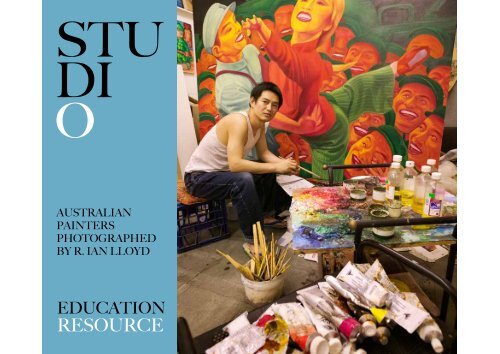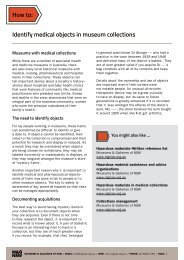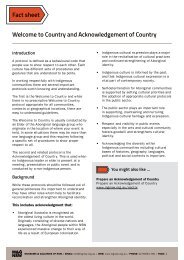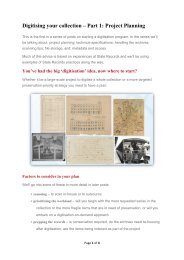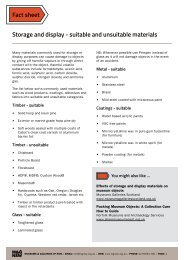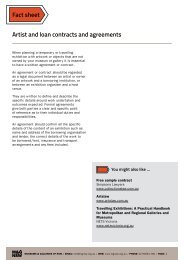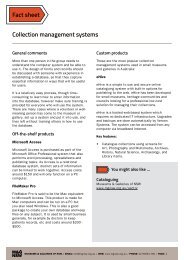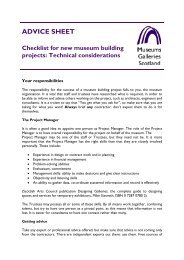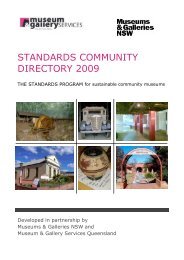STUDIO education resource - Museums & Galleries NSW
STUDIO education resource - Museums & Galleries NSW
STUDIO education resource - Museums & Galleries NSW
You also want an ePaper? Increase the reach of your titles
YUMPU automatically turns print PDFs into web optimized ePapers that Google loves.
AUSTRALIAN<br />
PAINTERS<br />
PHOTOGRAPHED<br />
BY R. IAN LLOYD<br />
EDUCATION<br />
RESOURCE<br />
exhibition<br />
<strong>resource</strong>
CONTENTS<br />
3 ABOUT THIS RESOURCE<br />
4 MAP OF ARTISTS<br />
5 PICK A PALETTE<br />
6 FACE PAGE<br />
7 THE <strong>STUDIO</strong> JOURNEY<br />
8 ABOUT THE PHOTOGRAPHER<br />
9 ABOUT THE ARTS WRITER<br />
10 ANGUS NIVISON<br />
14 MARION BORGELT<br />
19 LUCY CULLITON<br />
23 JULIE DOWLING<br />
27 GUO JIAN<br />
32 JOHN MAWURNDJUL<br />
36 WILLIAM ROBINSON<br />
40 JOHN WOLSELEY<br />
44 ANNA PLATTEN<br />
48 ROSELLA NAMOK<br />
53 ACKNOWLEDGEMENTS
ABOUT THIS RESOURCE<br />
This <strong>education</strong> <strong>resource</strong> has been produced by <strong>Museums</strong> and <strong>Galleries</strong><br />
<strong>NSW</strong> to support the national tour of the exhibition <strong>STUDIO</strong>: Australian<br />
Painters photographed by R. Ian Lloyd.<br />
The aim of this <strong>resource</strong> is to engage teachers and students with the<br />
exhibition and offer insights into artists’ studio practice via the photographs<br />
exploring these themes. The <strong>resource</strong> is intended to generate ideas for the<br />
classroom and encourage student research. It can be used as a basis for<br />
discussion before, during and after a visit to the exhibition.<br />
The <strong>resource</strong> introduces ten artists from the sixty-one photographed by<br />
Lloyd and offers focus questions and suggested activities. It also provides<br />
background information on the journey undertaken by Lloyd and art critic<br />
John McDonald across Australia.<br />
This <strong>resource</strong> can be used in a variety of ways - as a printed or online<br />
document for individual study or group work, and/or a web-enabled<br />
presentation on an interactive whiteboard or data projector. You can view<br />
the PDF as a slide show by going to view full-screen mode. There are four<br />
active content pages that allow you to explore each artist and the <strong>STUDIO</strong><br />
photographs from different entry points.<br />
The material is intended to complement the information provided in the<br />
<strong>STUDIO</strong> book, <strong>STUDIO</strong> DVD and the didactic panels in the exhibition.<br />
Teachers are invited to adapt the <strong>resource</strong> to suit their students’ needs, or<br />
select and integrate sections into existing units of study.<br />
_________<br />
_________<br />
________<br />
________<br />
________<br />
________<br />
________<br />
________<br />
_________<br />
_________<br />
_________<br />
_________<br />
_________<br />
_________<br />
This symbol links to activities<br />
that engage students in the<br />
formal qualities of the <strong>STUDIO</strong><br />
photographs.<br />
This symbol links to activities<br />
that invite students to explore Ian<br />
Lloyd’s documentary photographs<br />
and his practice.<br />
This symbol links to<br />
activities where students will<br />
explore the qualities of the works<br />
of art produced by the featured<br />
artists. Students will also engage<br />
in their own art making activities in<br />
response to these works.<br />
Lines are provided throughout the<br />
<strong>resource</strong> for teachers and students<br />
to add relevant tasks or notes in<br />
response to the artist, artwork or<br />
photograph depicted.<br />
In a PDF you can type to add<br />
text. On a SMART board you may<br />
use your marker to add notes in<br />
this space or use as a printed<br />
worksheet for student responses<br />
during the exhibition.<br />
Active web links are provided<br />
to further explore the artists<br />
and the key themes behind the<br />
exhibition.<br />
Go to Contents NEXT BACK
JULIE DOWLING<br />
EXPLORE THE TEN ARTISTS IN<br />
THIS RESOURCE BY CLICKING ON<br />
THEIR NAME.<br />
ANNA PLATTEN<br />
JOHN MAWURNDJUL<br />
ROSELLA NAMOK<br />
ANGUS NIVISON<br />
LUCY CULLITON<br />
JOHN WOLSELEY<br />
WILLIAM ROBINSON<br />
MARION BORGELT<br />
Guo Jian<br />
return to Contents NEXT BACK
CLICK ON THE ARTISTS’<br />
PALETTES TO DISCOVER<br />
THEIR <strong>STUDIO</strong>S<br />
return to Contents NEXT<br />
BACK
CAN YOU PICK THE TEN ARTISTS? WHO IS THE PHOTOGRAPHER? WHO IS THE ART CRITIC?<br />
CLICK ON EACH FACE TO FIND OUT WHAT CREATIVE WORK EACH OF THESE PEOPLE DO?<br />
return to Contents NEXT<br />
BACK
IAN LLOYD & JOHN MCDONALD<br />
return to Contents NEXT<br />
BACK
ABOUT THE PHOTOGRAPHER<br />
R. Ian Lloyd began his career as a travel photographer. He has since become<br />
a successful documentary photographer who has undertaken commissions<br />
for magazines such as National Geographic, Fortune and Time, and has won<br />
numerous awards for his work. He has photographed 35 books on countries<br />
and regions around Asia including large format books on Kathmandu, Bali<br />
and Singapore; and a four volume series on Australian Wine Regions. His<br />
photographs have been widely exhibited around the world.<br />
Ian Lloyd undertook the <strong>STUDIO</strong> project with the aim of capturing a broad<br />
cross-section of artists from all over Australia working in a variety of styles.<br />
Ian Lloyd was born in Canada, studied photography in the U.S., and first<br />
arrived in Australia in 1975.<br />
IAN LLOYD AND<br />
THE ART CRITIC<br />
JOHN MCDONALD<br />
TRAVELED<br />
MORE THAN<br />
50,000KM,<br />
AND SHOT<br />
50 HOURS OF<br />
VIDEO FOOTAGE<br />
OF 61 IMPORTANT<br />
PAINTERS WORKING<br />
IN THEIR <strong>STUDIO</strong><br />
ENVIRONMENT.<br />
return to Contents NEXT<br />
BACK
ABOUT THE WRITER<br />
John McDonald studied at Sydney University. For over twenty years he<br />
has been one of Australia’s best-known art critics, writing a weekly column<br />
for the Sydney Morning Herald, and contributing to local and international<br />
publications. As Head of Australian Art at the National Gallery of Australia<br />
in 2000, John was curator of the exhibition, Federation: Australian Art &<br />
Society 1901-2001, which toured the country for eighteen months. He has<br />
written numerous catalogue essays, and monographs on artists. He has also<br />
written on films, travel and even cricket. As a lecturer, John has appeared at<br />
colleges and public forums throughout Australia, and has taught Art History<br />
and Theory at the National Art School, Sydney.<br />
John McDonald was born in Cessnock, <strong>NSW</strong>, in 1961.<br />
FOR AN ARTIST, THE<br />
<strong>STUDIO</strong> IS THE ENGINE<br />
ROOM OF HIS OR HER<br />
CREATIVITY. IT IS BOTH<br />
PLAYGROUND AND PRISON<br />
CELL, THE PLACE WHERE<br />
LONG, LONG DAYS ARE<br />
SPENT WRESTLING WITH<br />
THE MUSE.<br />
John McDonald<br />
return to Contents NEXT<br />
BACK
ANGUS NIVISON<br />
return to Contents NEXT<br />
BACK
ANGUS NIVISON<br />
ANGUS NIVISON<br />
WALCHA, <strong>NSW</strong><br />
Angus Nivison has the messiest studio in the country. Surrounded by paper,<br />
paint, art books, newspapers and drawing materials, he makes works that<br />
can be described as quiet, contemplative and soulful.<br />
R Ian Lloyd’s photograph of Nivison is more than a portrait of the artist in<br />
his studio, it is a portrait of his painting process. By cluttering up his space<br />
Nivison can make happy accidents and discover new ideas. Although he<br />
says that his approach to every picture is different, ‘it always starts in chaos<br />
and ends in relief.’<br />
Nivison says that he has a fear of empty space (known in Latin as horror<br />
vacuii ) – a fear that many artists feel when contemplating a blank canvas or<br />
a new work of art. Nivison says he conquers the terror of the blank canvas<br />
by ‘ruining’ it: ‘I slaughter it and then try to save it. That’s how you get around<br />
painter’s block: make huge mistakes instantly. Do your worst straight away!’<br />
Born in 1953, Nivison lives in Walcha, in the New England district of New<br />
South Wales, where his family has farmed for generations. When he is<br />
not making art, he sometimes works on his brother’s farm. His drawings,<br />
paintings and their titles often refer to rain. It is as though by painting rain<br />
that Nivison can bring rain to a drought stricken landscape.<br />
Explore more of Nivison’s practice:<br />
http://focusmag.com.au/ne/our-area/local_artists/angus-nivison<br />
http://www.utopiaartsydney.com.au/angusnivison.htm<br />
Explore Walcha where Nivison works and lives:<br />
http://www.abc.net.au/landline/content/2006/s2104299.htm<br />
Write as many words<br />
as you can to describe<br />
Nivison’s studio – fill a whole<br />
page with these words and try<br />
to write or draw these words<br />
in a way that captures their<br />
meaning.<br />
Look closely at the photograph<br />
and write a list of the things that<br />
you can see in the photograph<br />
that may influence Nivison’s<br />
work. Is there anything<br />
missing from this studio?<br />
Where has the<br />
photographer Ian Lloyd<br />
positioned himself to take this<br />
picture? Why did he choose<br />
this angle?<br />
Take a series of photographs<br />
of a familiar subject from<br />
different viewpoints. Which<br />
best suits your chosen subject<br />
matter and why?<br />
return to Contents NEXT<br />
BACK
ANGUS NIVISON<br />
Angus Nivison, Loss, 2006, acrylic on canvas, 120 x 105cm<br />
“I SLAUGHTER IT AND<br />
THEN TRY TO SAVE IT.<br />
THAT’S HOW YOU GET<br />
AROUND PAINTER’S<br />
BLOCK: MAKE HUGE<br />
MISTAKES INSTANTLY.<br />
DO YOUR WORST<br />
STRAIGHT AWAY!”<br />
Angus Nivison 2006<br />
return to Contents NEXT BACK
ANGUS NIVISON<br />
Look at the<br />
painting by Angus Nivison.<br />
How would you describe<br />
it? Is it large or small? Is it<br />
a landscape or an abstract<br />
painting? What materials can<br />
you find in Nivison’s studio<br />
that might have been used to<br />
make this picture?<br />
Use materials that are similar<br />
to those used by Nivison to<br />
make your own work of art<br />
about the weather. You may<br />
wish to focus on the type of<br />
weather that is not common<br />
in your environment.<br />
______________________<br />
______________________<br />
______________________<br />
_____________________<br />
______________________<br />
______________________<br />
______________________<br />
_____________________<br />
_____________________<br />
_____________________<br />
_____________________<br />
_____________________<br />
_____________________<br />
_____________________<br />
_______________________<br />
_______________________<br />
_______________________<br />
_______________________<br />
______________________<br />
_______________________<br />
return to Contents NEXT BACK
eturn to Contents NEXT BACK<br />
MARION BORGELT
MARION BORGELT<br />
MARION BORGELT<br />
SYDNEY, <strong>NSW</strong><br />
Marion Borgelt must have one of the tidiest studios in the country and unlike<br />
artist Angus Nivison, who thrives in chaos, Borgelt needs a clean slate to<br />
begin working. Ian Lloyd’s photograph of Borgelt’s studio is devoid of the<br />
paint splatters and informality that one usually associates with artists.<br />
Borgelt’s art is as pristine as her inner city studio, and her works of art<br />
are best viewed on gallery style white walls where their rich colour and<br />
strong optics can best take effect. In fact Borgelt’s studio is like a private<br />
art gallery where the artist can experiment with the placement of her work<br />
before sending it out into the public.<br />
Borgelt’s works of art seem to straddle sculpture and painting. In her own<br />
words, ‘technically they’re not just paintings because there’s very little flat<br />
work involved...most pieces interface between sculpture and painting, and<br />
some of them are completely off the wall...’ Bloodlight Strip Figure 4 2006<br />
is a round painting, also known as a tondo, and rather than having a flat<br />
painted surface it is as though the painting has been cut from its stretcher<br />
and rearranged into a dramatic, radiating design.<br />
Born in 1954, Borgelt has lived in many cities including Adelaide, New York,<br />
Canberra, Paris and Perth. She now works in inner city Sydney. The studio<br />
world that she creates could similarly be anywhere - it is a world in itself.<br />
Explore the artist’s website<br />
www.marionborgelt.com/<br />
Learn more about the artist:<br />
Look closely at the<br />
photograph of Borgelt in<br />
her studio. Identify and list<br />
any art making materials or<br />
tools that you can see. Is<br />
there anything unusual about<br />
your list? Where would you<br />
usually find these objects?<br />
Imagine viewing Borgelt‘s<br />
Bloodlight Strip Figure 4 2006<br />
from every possible direction.<br />
How do these different<br />
perspective change the work.<br />
______________________<br />
______________________<br />
______________________<br />
_____________________<br />
______________________<br />
______________________<br />
______________________<br />
_____________________<br />
_____________________<br />
_____________________<br />
www.anu.edu.au/mac/images/uploads/MarionBorgelt_EducationResource.pdf<br />
return to Contents NEXT BACK
MARION BORGELT<br />
Marion Borgelt, Bloodlight Strip Figure 4, 2006, linen, acrylic, pigments, nails, wood,<br />
Perspex box, 75 W x 72 H x 6.5cm D<br />
“TECHNICALLY<br />
THEY’RE NOT<br />
JUST PAINTINGS<br />
BECAUSE THERE’S<br />
VERY LITTLE FLAT<br />
WORK INVOLVED...<br />
MOST PIECES<br />
INTERFACE BETWEEN<br />
SCULPTURE AND<br />
PAINTING, AND<br />
SOME OF THEM ARE<br />
COMPLETELY OFF<br />
THE WALL...’”<br />
Marion Borgelt 2006<br />
return to Contents NEXT BACK
MARION BORGELT<br />
Ian Lloyd took<br />
several other photographs of<br />
Borgelt in her studio. Compare<br />
the published photograph<br />
with this photograph, showing<br />
Borgelt surrounded by the tools<br />
of her trade. Why do you think<br />
Lloyd chose to exhibit the more<br />
minimalist photograph?<br />
Imagine Borgelt is holding the<br />
camera and looking back at the<br />
photographer – imagine what<br />
she would see through the lens.<br />
______________________<br />
BACK<br />
______________________<br />
______________________<br />
_____________________<br />
______________________<br />
______________________<br />
______________________<br />
_____________________<br />
_____________________<br />
_____________________<br />
_____________________<br />
_____________________<br />
_____________________<br />
_____________________ Contents<br />
_______________________<br />
_______________________ to<br />
_______________________<br />
_______________________<br />
______________________<br />
_______________________ return<br />
NEXT
MARION BORGELT<br />
Limit yourself<br />
to just two colours and create a<br />
circular work of art.<br />
Inspired by Borgelt’s way of<br />
working, cover a flat surface<br />
with a rich, strong colour. Once<br />
the surface is dry experiment<br />
with different ways of cutting,<br />
folding, twisting or pleating the<br />
surface to turn two dimensions<br />
into three.<br />
______________________<br />
______________________<br />
______________________<br />
_____________________<br />
______________________<br />
______________________<br />
______________________<br />
_____________________<br />
_____________________<br />
_____________________<br />
_____________________<br />
_____________________<br />
_____________________<br />
_____________________<br />
_______________________<br />
_______________________<br />
_______________________<br />
_______________________<br />
______________________<br />
_______________________<br />
_______________________<br />
_______________________<br />
_______________________<br />
return to Contents NEXT BACK
eturn to Contents NEXT BACK<br />
LUCY CULLITON
LUCY CULLITON<br />
LUCY CULLITON<br />
HARTLEY, <strong>NSW</strong><br />
When this photograph was taken, Lucy Culliton lived at home with her<br />
parents on their property at Hartley, west of the Blue Mountains in New<br />
South Wales. Her studio, a large prefabricated metal shed, was her own<br />
private refuge. Culliton built the studio after winning a painting prize and<br />
describes it as more than a place for painting. In her own words, ‘I’ve got<br />
my lounge, my kettle, my music. I’ve got my menagerie of animals, I’ve got<br />
my garden.’<br />
These things are very much part of Culliton’s daily life and they often become<br />
the subjects of her paintings. According to art critic John McDonald ‘she<br />
surrounds herself with animate and inanimate things, and then paints their<br />
portraits’. Culliton likes to explore how things look en masse and rather<br />
than painting a single plant or object, she often crowds her paintings with a<br />
single subject to make large, riotous compositions.<br />
In Cactus 2004 many different types of cacti fill the painting. Although<br />
cacti flower at different times, Culliton has shown them all in flower in this<br />
painting. Culliton obsessively paints one subject until she feels that she has<br />
exhausted that subject, and then she moves on to something else.<br />
Born in 1966, Culliton now lives on a property on the Monaro Plains in<br />
southern New South Wales. Her new home includes her cactus garden.<br />
See Culliton step out of the<br />
studio and into the classroom:<br />
www.abc.net.au/arts/stories/s2705313.htm<br />
A menagerie is an<br />
old fashioned word for a<br />
collection of animals. Name<br />
all of the animals you can<br />
see in Culliton’s studio. Don’t<br />
forget to scan the walls for<br />
evidence.<br />
Play a game of spot the<br />
difference where you<br />
compare and contrast<br />
Culliton’s painting Cactus<br />
2004 with the painting that is<br />
unfinished in her studio.<br />
By cluttering as<br />
many things as possible into<br />
this photograph of Culliton<br />
in her studio, photographer<br />
Ian Lloyd has used the<br />
same ideas of repetition<br />
and crowding that Culliton<br />
uses in her paintings. What<br />
is the overall effect of this<br />
technique?<br />
Do you have a collection?<br />
Is it of animate or inanimate<br />
things? Photograph your<br />
own collection, or someone’s<br />
you know if you don’t have<br />
one. Give your series of<br />
photographs a title that tells<br />
the audience something<br />
about the collector.<br />
return to Contents NEXT BACK
LUCY CULLITON<br />
“I’VE GOT MY LOUNGE, MY<br />
KETTLE, MY MUSIC.<br />
I’VE GOT MY MENAGERIE<br />
OF ANIMALS, I’VE GOT MY<br />
Lucy Culliton, Cactus, 2004, oil on canvas, 202 x 103cm<br />
GARDEN.”<br />
Lucy Culliton 2006<br />
return to Contents NEXT BACK
LUCY CULLITON<br />
Do a<br />
close up drawing of your<br />
favourite thing in the <strong>STUDIO</strong><br />
photograph, translate this<br />
drawing into a painting and<br />
use the colours Culliton has<br />
used on her palette.<br />
Display your painting with<br />
those of your classmates in a<br />
grid. Photograph the artists in<br />
front of the display.<br />
______________________<br />
______________________<br />
______________________<br />
_____________________<br />
______________________<br />
______________________<br />
______________________<br />
_____________________<br />
_____________________<br />
_____________________<br />
_____________________<br />
_____________________<br />
_____________________<br />
_____________________<br />
return to Contents NEXT BACK
eturn to Contents NEXT BACK<br />
JULIE DOWLING
JULIE DOWLING<br />
JULIE DOWLING<br />
PERTH, WA<br />
Julie Dowling is an Indigenous artist of the West Australian Badimaya/<br />
Yamatji language group. She lives in Perth with her mother and twin sister<br />
and her studio is a demountable trailer set up in the backyard. Her studio<br />
had a previous life as temporary accommodation for miners in the Pilbara<br />
region of Western Australia.<br />
Dowling is passionate about putting into paint the stories of her community<br />
and her ancestors. Ian Lloyd’s photograph of Dowling’s studio shows old<br />
photographs pinned to the walls alongside fresh portraits. For Dowling, her<br />
ancestors are ever present and their stories directly inform her painting.<br />
Often when Dowling is painting, she has company – friends and family sit<br />
around sharing stories and opinions and this ‘yarning’ makes its way into<br />
her paintings. In her own words, ‘I don’t feel that the work itself is mine,<br />
even when I’m painting. It belongs to my community. It may sound strange,<br />
but that’s how it is.’<br />
Dowling and her twin sister were born in 1966 with fair skin. Dowling’s<br />
paintings assert her Aboriginality, connecting the past and the present and<br />
keeping alive the oral histories of her people.<br />
Look closely at the<br />
photograph of Dowling in her<br />
studio and describe some of<br />
the other things that you can<br />
see in her studio that might<br />
influence her work.<br />
Look at Dowling’s painting.<br />
Experiment by using drawn<br />
patterns to create, hide and<br />
reveal words in your work.<br />
Ian Lloyd’s portrait<br />
of Dowling shows the artist<br />
surrounded by other portraits.<br />
If you were photographed by<br />
ian Lloyd what type of things<br />
would you choose to be<br />
surrounded by?<br />
Make a list of the things that<br />
would be in the background<br />
of the photograph if you<br />
were photographed in your<br />
bedroom.<br />
Read ABC interview including Dowling and her twin Carol:<br />
www.abc.net.au/tv/messagestick/stories/s1590834.htm<br />
Explore the NGA’s collection of her work:<br />
www.ngv.vic.gov.au/ngvschools/TraditionAndTransformation/artists/Julie-Dowling/<br />
return to Contents NEXT BACK
JULIE DOWLING<br />
Julie Dowling, Dispossession Series: My Great Uncle George, 2004, acrylic and red ochre<br />
on canvas, 120 x 100cm<br />
“I DON’T FEEL<br />
THAT THE WORK<br />
ITSELF IS MINE,<br />
EVEN WHEN I’M<br />
PAINTING.<br />
IT BELONGS TO<br />
MY COMMUNITY.<br />
IT MAY SOUND<br />
STRANGE, BUT<br />
THAT’S HOW IT IS.”<br />
Julie Dowling 2006<br />
return to Contents NEXT BACK
JULIE DOWLING<br />
D e s p i t e<br />
the fact that many of the<br />
stories from her past are<br />
sad, Dowling likes to make<br />
celebratory paintings and<br />
she often uses glitter mixed<br />
in with paint to brighten her<br />
canvasses. Create a painting<br />
where you celebrate a friend.<br />
Collect papers, images and<br />
information for a week and<br />
make a work about an issue<br />
that is important to you.<br />
______________________<br />
______________________<br />
______________________<br />
_____________________<br />
______________________<br />
______________________<br />
______________________<br />
_____________________<br />
_____________________<br />
_____________________<br />
_____________________<br />
_____________________<br />
_____________________<br />
_____________________<br />
_______________________<br />
_______________________<br />
_______________________<br />
_______________________<br />
______________________<br />
_______________________<br />
_______________________<br />
_______________________<br />
_______________________<br />
return to Contents NEXT BACK
eturn to Contents NEXT BACK<br />
GUO JIAN
GUO JIAN<br />
Guo Jian<br />
Sydney, <strong>NSW</strong><br />
Guon Jian lives and makes art from his studio apartment that overlooks<br />
Sydney’s busy Parramatta Road. The small space is crammed with plastic<br />
toys and models, books, magazines, postcards and posters. He often paints<br />
at night and will work on more than one painting at a time when he is feeling<br />
inspired. His dream, he says, is to have a really big studio - ‘I’d like to have<br />
lots of paintings on the go, and ride around on a bicycle looking at them.’<br />
Ian Lloyd’s photograph shows Guo Jian in the studio, dressed in his military<br />
uniform and making a face in the mirror. Before coming to Australia in 1992<br />
Guo Jian served almost four years in Chinese People’s Liberation Army<br />
and this experience haunts him to this day. ‘In China we have this military<br />
culture,’ he explains. ‘You see soldiers everywhere you go. That’s why I<br />
keep painting these subjects.’<br />
Guo Jian’s large, predominantly red and green canvases, depict pin up<br />
girls like those shown on the posters in his studio, and grinning soldiers<br />
that carry the artist’s own face. By using his own face in every painting he<br />
relives past experiences and mocks the seriousness of his subjects, as<br />
seen in the painting titled The Day Before I Went Away 2003.<br />
Born in 1963, Guo Jian now spends his time living between China and<br />
Australia.<br />
Explore the artist’s website:<br />
www.guojiantheartist.com/<br />
Compare the two<br />
studio photographs of Guo<br />
Jian located on the previous<br />
page and the next page. What<br />
do the images say about the<br />
painter? Why do you think<br />
Ian Lloyd chose to exhibit the<br />
photograph showing the artist<br />
in military uniform?<br />
What would your ideal studio<br />
be like – small or very large?<br />
How would you choose to get<br />
around it?<br />
Find your favourite studio<br />
among those in the exhibition.<br />
Why is this your favourite?<br />
______________________<br />
______________________<br />
______________________<br />
_____________________<br />
______________________<br />
______________________<br />
______________________<br />
_____________________<br />
_____________________<br />
_____________________<br />
The White Rabbit Collection in Sydney is one of the world’s largest<br />
and most significant collections of contemporary Chinese art. Explore<br />
this collection:<br />
www.whiterabbitcollection.org/<br />
return to Contents NEXT BACK
GUO JIAN<br />
Look at the exhibited<br />
<strong>STUDIO</strong> photograph. A studio<br />
says alot about an artist’s<br />
influences. Make a list of the<br />
books you think have inspired<br />
Guo Jian the most. Does your<br />
book shelf at home reflect<br />
who you are?<br />
Locate other portraits in<br />
the exhibition that include<br />
dressing up, role play and<br />
performance.<br />
Collect together your<br />
favourite toys, trinkets and<br />
souvenirs. Group them in<br />
interesting ways – perhaps<br />
according to size or colour<br />
and then document them<br />
using a camera.<br />
______________________<br />
______________________<br />
______________________<br />
_____________________<br />
______________________<br />
______________________<br />
______________________<br />
_____________________<br />
_____________________<br />
_____________________<br />
_____________________<br />
return to Contents NEXT BACK
GUO JIAN<br />
Guo Jian, The Day Before I Went Away, 2003, oil on canvas, 213 x 152cm<br />
“I’D LIKE TO<br />
HAVE LOTS OF<br />
PAINTINGS ON<br />
THE GO, AND<br />
RIDE AROUND<br />
ON A BICYCLE<br />
LOOKING AT<br />
THEM.”<br />
Guo Jian 2006<br />
return to Contents NEXT BACK
GUO JIAN<br />
Play a game<br />
of celebrity heads where you<br />
paint or Photoshop your face<br />
into famous portraits from<br />
history.<br />
Take portraits of your friend<br />
that incorporate a mirror. Pull<br />
silly or serious faces that are<br />
revealed in the mirror. Try<br />
to reflect the camera and<br />
photographer in the mirror to<br />
make it a double portrait.<br />
BACK<br />
______________________<br />
______________________<br />
______________________<br />
_____________________<br />
______________________<br />
______________________<br />
______________________<br />
_____________________<br />
_____________________<br />
_____________________<br />
_____________________<br />
_____________________<br />
_____________________ Contents<br />
_____________________<br />
to<br />
_______________________<br />
_______________________<br />
_______________________<br />
_______________________<br />
______________________ return<br />
NEXT
JOHN MAWURNDJUL<br />
return to Contents NEXT<br />
BACK
JOHN MAWURNDJUL<br />
JOHN MAWURNDJUL<br />
KUNWINJKU COUNTRY, NT<br />
John Mawurndjul’s studio is his country, Kunwinjku country, in Arnhem<br />
land in northern Australia. Mawurndjul works mostly outside – often under<br />
an awning that runs from his house situated in his traditional homelands.<br />
Sometimes he works in the larger centre of Maningrida where he visits for<br />
art business and to see friends and family.<br />
This photograph by Ian Lloyd was taken in Maningrida at a friend’s house,<br />
the day before Mawurndjul traveled to Paris to work on a commission for<br />
the Quai Branly museum. Mawurndjul is shown sitting crossed legged on<br />
the ground with a hollow log in front of him. He applies ochre, ground from<br />
a stone, with a brush made from only a few long hairs, to the log or bark in<br />
a delicate pattern of lines known as rrark.<br />
While Mawurndjul’s patterns may appear abstract they are actually the<br />
secret marks of a traditional ceremony known as the Mardayin ceremony.<br />
The enactment of this ceremony is the subject of his large bark painting<br />
titled Mardayin at Dilebang 2005. Painted directly onto bark, Mawurndjul<br />
uses PVA glue to help bind the ochre and give the surface a shimmering<br />
effect. The bark used in painting is harvested during the wet season from<br />
the large stringy bark trees, which are a type of Eucalyptus tree, found<br />
across his country.<br />
Born in 1952, Mawurndjul began painting in the late 1970s and today he is<br />
widely acknowledged as the greatest living bark painter.<br />
Using a world<br />
map find the place where<br />
Mawurndjul lives on a map.<br />
Shade in the area of Arnhem<br />
Land. Find Paris on the map<br />
then mark the journey.<br />
What music is he playing<br />
on the stereo? What music<br />
do you to listen to when you<br />
work?<br />
Can you find evidence of<br />
music in the other artists’<br />
studios?<br />
Look at the palette<br />
photograph and compare<br />
Mawurndjul’s ochre painting<br />
process with other painting<br />
processes in the <strong>resource</strong>.<br />
Choose two palette pictures<br />
and annotate these by listing<br />
the materials, tools and<br />
processes you can see.<br />
Watch the Art and Soul video<br />
to discover how Mawurndjul<br />
harvests the bark for his<br />
works:<br />
www.abc.net.au/arts/artandsoul/flash/default.htm<br />
return to Contents NEXT BACK
JOHN MAWURNDJUL<br />
John Mawurndjul, mardayin at Dilebang, 2005, natural pigments on bark, 143 x 74cm<br />
“HE GRINDS A LITTLE<br />
OCHRE FROM A STONE,<br />
MIXES IT WITH WATER<br />
AND GLUE, AND DIPS A<br />
BRUSH WITH A FEW LONG<br />
THIN HAIRS INTO THE<br />
COLOUR. WITH A STEADY<br />
HAND, HE APPLIES LINE<br />
AFTER LINE TO THE LOG.<br />
A TYPICAL PAINTING MAY<br />
TAKE TWO TO THREE<br />
WEEKS OF PATIENT,<br />
UNREMITTING TOIL.”<br />
John McDonald 2006<br />
return to Contents NEXT<br />
BACK
JOHN MAWURNDJUL<br />
Extend the<br />
<strong>STUDIO</strong> picture. What else<br />
is around and what does<br />
Mawurndjul’s country look<br />
like? Use Photoshop or paper<br />
collage to extend the picture.<br />
Make up a secret visual<br />
language that relates to<br />
your life. Create a glossary<br />
of symbols and paint them<br />
to narrate a story. Give the<br />
glossary to a friend and show<br />
them your work. Do they<br />
know what the work means<br />
to you?<br />
______________________<br />
______________________<br />
______________________<br />
_____________________<br />
______________________<br />
______________________<br />
______________________<br />
_____________________<br />
_____________________<br />
_____________________<br />
_____________________<br />
_____________________<br />
_____________________<br />
_____________________<br />
_______________________<br />
_______________________<br />
_______________________<br />
_______________________<br />
______________________<br />
return to Contents NEXT BACK
eturn to Contents<br />
return to Contents NEXT BACK<br />
WILLIAM ROBINSON
WILLIAM ROBINSON<br />
WILLIAM ROBINSON<br />
BRISBANE, QLD<br />
William Robinson’s studio is on the ground floor of his house in a Brisbane<br />
beachside suburb. Here he works to a strict daily routine and, unlike artist<br />
John Wolseley, Robinson relishes the structure and organisation of his<br />
studio practice which includes daily walks and playing the piano.<br />
When Robinson was a young man he trained to be a concert pianist. Music<br />
is still very much part of his daily life. As he says ‘I rarely - in fact never - paint<br />
without music. Some artists need absolute silence, but I need to create a<br />
situation where I find the painting rather than impose myself upon it. I need<br />
to be in a state where total consciousness is suspended…but in order to<br />
feel that, I must go into some sort of a state that only music can provide.’<br />
Robinson has lived in or near Brisbane for most of his life. Despite this,<br />
most of his inspiration comes from the rainforest near Springbrook which<br />
is about 100 km south of Brisbane. He and his wife Shirley have a small<br />
house in the rainforest that they regularly visit. His painting Nerang River<br />
Pool 2004 with its vaulted perspective captures the whole experience of the<br />
landscape.<br />
Born in 1936, Robinson claims that it has taken many years of walking in the<br />
rainforest, making notes and sketches, to find his singular, visual language.<br />
Why are there pastels<br />
in the studio photograph.<br />
Does Robinson use them<br />
for preliminary studies? The<br />
painters in this <strong>resource</strong> use a<br />
variety of materials including<br />
glitter, pastels, house paint<br />
and oil paints. Compare the<br />
different materials used.<br />
Make up an adventure story<br />
based on the painting Nerang<br />
River Pool 2004.<br />
How does Robinson<br />
work and where do his ideas<br />
come from? Are there any<br />
clues in the studio?<br />
How many of the <strong>STUDIO</strong><br />
artists are using materials to<br />
create works of art while their<br />
photograph is being taken?<br />
Explore the adventure of Robinson’s work:<br />
www.visualarts.qld.gov.au/content/robinson_standard.asp?name=Robinson_Hide_Seek<br />
return to Contents NEXT BACK
WILLIAM ROBINSON<br />
William Robinson, Nerang River Pool. 2004, oil on linen, 122 x 183cm<br />
“I RARELY - IN<br />
FACT NEVER -<br />
PAINT WITHOUT<br />
MUSIC. SOME<br />
ARTISTS NEED<br />
ABSOLUTE<br />
SILENCE, BUT I<br />
NEED TO CREATE<br />
A SITUATION<br />
WHERE I FIND<br />
THE PAINTING<br />
RATHER THAN<br />
IMPOSE MYSELF<br />
UPON IT.”<br />
William Robinson 2006<br />
return to Contents NEXT BACK
WILLIAM ROBINSON<br />
Lie under<br />
a tree and draw your<br />
experience of the sky through<br />
the tree using pastels.<br />
Develop two paintings from<br />
your sketch – listen to music<br />
that suits the mood of your<br />
emerging composition.<br />
Use classical piano music<br />
for the first and then<br />
contemporary music for the<br />
second – does the work<br />
change?<br />
______________________<br />
______________________<br />
______________________<br />
_____________________<br />
______________________<br />
______________________<br />
______________________<br />
_____________________<br />
_____________________<br />
_____________________<br />
_____________________<br />
_____________________<br />
_____________________<br />
_____________________<br />
_______________________<br />
_______________________<br />
_______________________<br />
_______________________<br />
______________________<br />
_______________________<br />
_______________________<br />
_______________________<br />
return to Contents NEXT BACK
eturn to Contents<br />
JOHN WOLSELEY<br />
return to Contents NEXT<br />
BACK
JOHN WOLSELEY<br />
JOHN WOLSELEY<br />
MELBOURNE, VIC<br />
John Wolseley’s studio is a large room in his apartment in St. Kilda,<br />
Melbourne. His preferred studio, however, is just about anywhere in the<br />
Australian bush. Wolseley spends as much time as he can out of the city<br />
- painting in an old train carriage, sketching in a tent or by the banks of a<br />
creek.<br />
Ian Lloyd’s photograph of Wolseley shows him drawing with the naturally<br />
formed charcoal found in a burnt piece of wood. Drawing is central to<br />
his way of working and Wolseley combines detailed natural history style<br />
drawing with expressive mark making where he sometimes uses elements<br />
direct from the landscape to draw with.<br />
The large roll of paper shown in the studio photograph has been covered<br />
in drawings made directly by the environment and as such it bears witness<br />
to the forces of nature. In his own words Wolseley says, ‘in this studio in<br />
St. Kilda, I’ve noticed that things have a more static quality. Whereas, if I’m<br />
outside, under my tarpaulin, I feel the great forces and flux of nature moving<br />
through me.’<br />
Born in 1938, Wolseley is fascinated by geology, science and natural<br />
history. These interests can be seen in A history of parrots, drifting maps<br />
and warming seas 2005 and are expressed in the following statement; ‘I<br />
feel a fundamental connection with nature. What I’m invariably doing in my<br />
work is relating the grasshopper’s leg, or the growth rings on a plant, to the<br />
bigger, more abstract geological systems of the earth.’<br />
Explore the artist’s works:<br />
www.johnwolseley.net/<br />
Survey John Wolseley’s work using Google image search:<br />
Devise a short poem<br />
about the artist John Wolseley<br />
in his studio.<br />
What things seem common<br />
among the painters in the<br />
exhibition? What can you see<br />
that are found in at least five<br />
other studio photographs?<br />
Why do you think<br />
lan Lloyd did not photograph<br />
Wolseley in the natural<br />
environment when he so<br />
often works there? Are there<br />
any other artists who work<br />
outdoors? List and compare<br />
each artist’s practice with<br />
Wolseley’s.<br />
______________________<br />
______________________<br />
______________________<br />
_____________________<br />
______________________<br />
______________________<br />
______________________<br />
_____________________<br />
http://www.google.com.au/images?um=1&hl=en&safe=off&biw=1152&bih=534&tbs=isch:1&aq=f&aqi=g2&oq=&gs_rfai=&q=john%20wolseley<br />
return to Contents NEXT BACK
JOHN WOLSELEY<br />
John Wolseley, A history of parrots, drifting maps and warming seas, 2005, watercolour, carbonised wood on paper, 66.5 x 346cm<br />
“...IN THIS <strong>STUDIO</strong> IN ST. KILDA, I’VE NOTICED THAT<br />
THINGS HAVE A MORE STATIC QUALITY. WHEREAS,<br />
IF I’M OUTSIDE, UNDER MY TARPAULIN, I FEEL THE<br />
GREAT FORCES AND FLUX OF NATURE MOVING<br />
THROUGH ME.”<br />
John Wolseley 2006<br />
return to Contents NEXT BACK
JOHN WOLSELEY<br />
Many artists<br />
work en plein air (outdoors).<br />
Using a large sheet of paper<br />
explore expressive mark<br />
making techniques using<br />
charcoal in response to the<br />
natural environment.<br />
Elements of John Wolseley’s<br />
work look like natural history<br />
illustration. Collect natural<br />
history images and maps to<br />
collage onto the background.<br />
Hand colour the images using<br />
watercolours.<br />
How was the experience of<br />
working outdoors compared<br />
to working indoors?<br />
______________________<br />
______________________<br />
______________________<br />
_____________________<br />
______________________<br />
______________________<br />
______________________<br />
_____________________<br />
_____________________<br />
_____________________<br />
_____________________<br />
_____________________<br />
_____________________<br />
_____________________<br />
return to Contents NEXT BACK
ANNA PLATTEN<br />
return to Contents NEXT<br />
BACK
ANNA PLATTEN<br />
ANNA PLATTEN<br />
ADELAIDE, SA<br />
Anna Platten’s crowded studio in inner city Adelaide resembles the prop<br />
room of a theatre. Costumes, furniture, drapes and bric-a-brac all vie for<br />
space and attention. The artist in her paint-splattered coat provides the only<br />
evidence that this is the studio of a painter.<br />
Platten’s process is different to that of many of the artists represented in<br />
<strong>STUDIO</strong>. In preparing to make a painting, Platten will position props and<br />
even sew garments for her models to wear. In her own words ‘I find that<br />
making the prop is essential, it helps me get into the mood of the painting.<br />
It’s a bit like an actor putting on make-up. Sometimes it allows me to flesh<br />
out an idea which is still very tenuous in my head.’<br />
Platten sometimes depicts herself in her paintings, such as in the large<br />
painting Myself as Madonna 2003. Many of the elements in this painting can<br />
be found in the photograph of her studio. Platten alludes to the Christian<br />
convention of Madonna and child paintings but adds a humorous touch with<br />
the inclusion of the pointy bra, a reference or double entendre to pop star<br />
Madonna.<br />
Born in 1957, Platten juggles the demands of being a mother, a teacher and<br />
an artist. Her paintings are frequently the stages on which the drama and<br />
the delight of these many, often competing roles, are performed.<br />
Explore the artist’s current work:<br />
http://www.evabreuerartdealer.com.au/platten.html<br />
Step into the studio<br />
with Platten. What would you<br />
make, assemble or perform in<br />
her space?<br />
Look at other examples of<br />
Platten’s work using Google<br />
image search – what features<br />
are recurring? Can you see<br />
any of her studio props in her<br />
other paintings.<br />
Where do you think<br />
Ian Lloyd has placed lights<br />
to illuminate the studio and<br />
why?<br />
Find photographs of<br />
Madonna in the 1980’s to<br />
see how Platten has been<br />
inspired by her costume.<br />
Make a work inspired by a<br />
photograph of your favourite<br />
musical artist.<br />
Look at this work to discover props used from Platten’s studio:<br />
http://www.unisa.edu.au/samstagmuseum/images/fullimage/support.asp<br />
return to Contents NEXT BACK
ANNA PLATTEN<br />
“IT’S A BIT LIKE AN<br />
ACTOR PUTTING<br />
ON MAKE-UP.<br />
SOMETIMES IT<br />
ALLOWS ME TO<br />
FLESH OUT AN<br />
IDEA WHICH<br />
IS STILL VERY<br />
TENUOUS IN MY<br />
HEAD.”<br />
Anna Platten 2006<br />
Anna Platten, Myself as Madonna, 2003, oil on canvas,<br />
165 x 195cm<br />
return to Contents NEXT BACK
ANNA PLATTEN<br />
Make a<br />
drawing of your favourite<br />
outfit – it can be fancy dress<br />
or everyday. Use the stage<br />
setting with red curtains to add<br />
drama to your composition.<br />
Look at Platten‘s palette. She<br />
uses traditional methods of<br />
mixing colours. Experiment<br />
with mixing your own colours<br />
and document your results.<br />
______________________<br />
______________________<br />
______________________<br />
_____________________ BACK<br />
______________________<br />
______________________<br />
______________________<br />
_____________________<br />
_____________________<br />
_____________________<br />
_____________________<br />
_____________________<br />
_____________________<br />
_____________________<br />
_______________________<br />
_______________________<br />
_______________________ Contents<br />
_______________________<br />
______________________ to<br />
_______________________<br />
_______________________<br />
_______________________<br />
_______________________ return<br />
NEXT
ROSELLA NAMOK<br />
return to Contents NEXT<br />
BACK
ROSELLA NAMOK<br />
ROSELLA NAMOK<br />
CAIRNS, QLD<br />
Rosella Namok is part of a group of young artists known as the Lockhart<br />
River Art Gang who are all from the remote community of Lockhart River in<br />
Cape York in far north Queensland.<br />
A few years ago Namok moved south to Cairns where she now has a studio<br />
in a converted double garage alongside her house. Ian Lloyd’s photograph<br />
shows Namok in her Cairns studio, which is large enough to make paintings<br />
like Big Rain…w’re Aangkum 2005 which is over 3 metres long.<br />
Namok paints using her fingers – creating contours and patterns in acrylic<br />
paint. This technique shows the influence of her grandmother who made<br />
sand drawings and her father, whom Namok helped as a young girl to paint<br />
the bodies of dancers for ceremonies. Namok paintings are often about<br />
the natural environment of Lockhart River and she also tells the stories of<br />
her people through her paintings. Namok says, ‘they always tell me lots of<br />
stories. My grandmother yarns, tells me things about the old mission, and<br />
the strong laws they used to have. That really helps me understand those<br />
days’.<br />
People and place are interconnected for Namok. Big Rain…w’re Aangkum<br />
2005 shows the wet season torrents but also refers to Namok’s language<br />
group through the use of the word Aangkum. Her paintings connect climate,<br />
country and kin.<br />
Born in 1979 Namok was just 20 when she had her first exhibition.<br />
______________________<br />
______________________<br />
______________________<br />
_____________________<br />
______________________<br />
______________________<br />
______________________<br />
_____________________<br />
_____________________<br />
_____________________<br />
See more of the artist’s works:<br />
www.andrew-baker.com/Rosella%20Namok_Ngatangku%20Ngaachi.pdf<br />
Learn more about this artist:<br />
www.artmuseum.uq.edu.au/docs/OurWayEducationKit.pdf<br />
Visually and<br />
conceptually compare Angus<br />
Nivison’s work to Namok’s.<br />
What are the similarities?<br />
What are the differences?<br />
Australia has a long tradition<br />
of telling yarns. Both Namok<br />
and Julie Dowling do<br />
this through their artwork.<br />
Create a yarn about Ian<br />
Lloyd’s journey to visit and<br />
photograph each artist.<br />
return to Contents NEXT BACK
ROSELLA NAMOK<br />
Rosella Namok, Big Rain … w’re Aangkum, 2005, acrylic on canvas, 350 x 175cm<br />
“MY GRANDMOTHER YARNS, TELLS ME THINGS<br />
ABOUT THE OLD MISSION, AND THE STRONG LAWS<br />
THEY USED TO HAVE. THAT REALLY HELPS ME<br />
UNDERSTAND THOSE DAYS.”<br />
Rosella Namok 2006<br />
return to Contents NEXT BACK
ROSELLA NAMOK<br />
Each layer of paint<br />
is a physical memory of the<br />
paintings made in a studio.<br />
Look at the floor of Namok’s<br />
studio. How many works do<br />
you think she has created<br />
there?<br />
Take photographs of your art<br />
classroom or studio.<br />
Ian Lloyd also photographed<br />
Namok with her dog. Ask<br />
a friend or family member<br />
to pose with their pet and<br />
document them using<br />
photography.<br />
Can you find other animals in<br />
the <strong>STUDIO</strong> photographs?<br />
______________________<br />
______________________<br />
______________________<br />
_____________________<br />
______________________<br />
______________________<br />
______________________<br />
_____________________<br />
_____________________<br />
_____________________<br />
_____________________<br />
return to Contents NEXT BACK
ROSELLA NAMOK<br />
Create your<br />
own weather painting. Write a<br />
story about the weather using<br />
lots of descriptive language.<br />
Exchange your story with a<br />
classmate. Create an artwork<br />
about their story. Does it<br />
look like the writer thought it<br />
would?<br />
Look at Namok’s palette. Why<br />
do you think she is working<br />
with her fingers. She is also<br />
holding a roller in the studio<br />
photograph. Create a large<br />
work using these methods.<br />
NEXT<br />
BACK<br />
______________________<br />
______________________<br />
______________________<br />
_____________________<br />
______________________<br />
______________________<br />
______________________<br />
_____________________<br />
_____________________ Contents<br />
_____________________<br />
_____________________ to<br />
_____________________<br />
_____________________<br />
_____________________<br />
_______________________ return
Acknowledgments:<br />
This <strong>education</strong> <strong>resource</strong> has been produced<br />
by <strong>Museums</strong> and <strong>Galleries</strong> <strong>NSW</strong> to support<br />
the national tour of the exhibition <strong>STUDIO</strong>:<br />
Australian Painters photographed by R. Ian<br />
Lloyd.<br />
Images:<br />
R. Ian Lloyd, Photographer<br />
Author:<br />
Lisa Slade, Education consultant<br />
Activities and design:<br />
Anna Scobie, Education consultant<br />
Editor:<br />
Rachel Arndt, Manager, Touring<br />
Exhibitions Services M&G<strong>NSW</strong><br />
All copyright reversed 2010. Photographs and<br />
images reproduced courtesy of the artists. The<br />
authors wish to acknowledge and thank John<br />
McDonald for the text extracts and quotations<br />
adapted for this <strong>resource</strong> from the interviews<br />
conducted during the <strong>STUDIO</strong> project.<br />
Writing tasks:<br />
John McDonald writes a column in the Sydney Morning Herald each<br />
weekend. He reviews exhibitions in Sydney and around the country. Visit the<br />
studio exhibition and write a review for your local paper. Collect a copy of the<br />
Sydney Morning Herald to research the information you will need to include<br />
in your own review.<br />
Write a journal entry of a day in the life of Ian Lloyd and John McDonald.<br />
Choose a day when they are going to take a photograph of your favourite<br />
studio and interview your favourite artist.<br />
Suggested comparisons:<br />
Contrast and compare the paintings of Rosella Namok and Angus<br />
Nivison who both depict the weather in their work through different cultural<br />
perspectives.<br />
Contrast and compare the self portraiture and performance aspects of Anna<br />
Platten’s and Guo Jian’s paintings.<br />
Compare the opposite natures of Angus Nivison’s and Marion Borgelt’s<br />
studio practice.<br />
Compare the drawing practice that is included in both John Wolseley’s and<br />
Angus Nivison’s paintings.<br />
Compare and contrast artists John Wolseley and John Mawurndjul who both<br />
explore concepts of country and landscape in their art practice.<br />
Explore the concepts of yarning and oral histories through the works of Julie<br />
Dowling and Rosella Namok.<br />
Connect the concept of collecting as inspiration by comparing the practice of<br />
Lucy Culliton and Guo Jian.<br />
return to Contents BACK<br />
EXit


